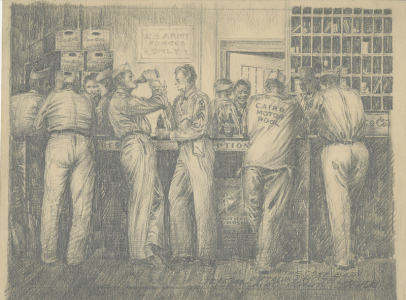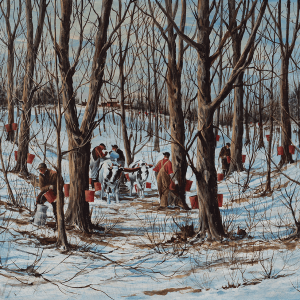Biography
If you had to imagine a painter of the American Scene, you would perhaps think of someone who spent his entire life in a small American town, with possible excursions to art school or even for wartime service. Precisely such a painter was Stephen Joseph Belaski. Born in New York in 1909, he grew up in Bellows Falls, VT and spent the bulk of his adult life there. While in Bellows Falls High School he was already a working artist, painting placards for shops in the town. He attended the Vesper George School of Art in Boston, where in 1931 the Boston Globe highlighted a Belaski mural in a review of a student art show.
Belaski received a 3-month scholarship for study in France, which he spent at the Fontainebleau School of Fine Arts. His instructors there were Jean Despujols, André Strauss, and Gaston Balande, from whom he was able to refine his mural technique. Returning to Bellows Falls, Belaski hoped to establish himself as a professional painter, but this was in the depths of the Depression, and there were no private clients to be found.
Belaski's prospects suddenly changed in 1934 when he received a call from the local head of the Daughters of the American Revolution (DAR). His caller told him of new federal support for the arts and asked if he might be willing to paint a historical mural on the subject of the Reverend John Williams and the sermon he delivered after being taken captive in Raid on Deerfield in 1704 during Queen Anne's War.
Belaski jumped at the chance, and within a week he was part of the WPA program for artists, writers and actors. His sketches were quickly approved, and he was told to work fast - in case the whole program collapsed before he could complete his mural. The WPA did not collapse, of course, and Belaski's mural showing John Williams preaching at the mouth of the Williams river was hung in the Bellows Falls High School after being exhibited first in Burlington, VT. The success of this mural led to another commission and a second mural for the High School, "Abenaki Indians Fishing at Great Falls," to honor the original inhabitants of Bellows Falls.
Word of Belaski's murals spread, and he was invited to create a series of seven murals for the newly-built Rutland, VT Post Office. These murals, completed in 1937, dealt with the early history of Vermont. And when that major project was completed, Belaski received another commission - for a pair of murals at the Officers Club at Fort Ethan Allen in Winooski, VT. These were completed in 1941, after which Belaski was drafted into the U.S. Army to serve as head of the drafting department in the General Headquarters for the Middle East. From 1942-1945 Belaski served in this capacity, working out of Cairo, Egypt. He made numerous sketches in addition to his drafting.
After the war, Belaski returned to Bellows Falls, where he took a job as art teacher back at Bellows Falls High School. He remained in this position until his retirement. He died in Vermont in 1987, not long after recording an oral history with his colleague at the High School, art teacher Mary Lou Massucco.


Critical Analysis
Belaski was an able muralist. He researched his historical subjects in painstaking detail and tried to render the incidents he portrayed as accurately as possible. What's remarkable about this dedicated regional muralist is that a significant fraction of his work has survived to this day. Some of it barely managed to survive, it is true, and some of his murals are even now undergoing restoration. But obviously the people of his Vermont community respected his creations enough to have protected them for nearly 90 years. His first murals - for the Bellows Falls High School - were restored in 1987 and currently hang in the Bellows Falls Middle School. His murals for the Robert T. Stafford U.S. Post Office and Courthouse remain in their original location, restored before the building's sale to the General Services Administration in 2016. And his murals for the Fort Ethan Allen Officer's Club were stored, if badly, at Fort Ticonderoga for many years and have recently been donated to the town of Rockingham, where it is hoped they will be displayed in the Town Hall in 2026.
In Belaski's oral history interview with Mary Lou Massucco, he stressed that his entire career in the 1930s was the result of his phone call from Mary Nims Bolles and her proposal that he paint something relating to the raid on Deerfield. It turns out that her interest went far beyond her participation in the local chapter of the DAR and was, in fact, a very personal issue for her. Among the hostages and victims of the raid on Deerfield were the Chapin and Nims families. Mary Nims Bolles was in fact a descendant of both families.
Murals
- Rutland, Vermont - Post Office: Early History of Vermont
References
- Robert F. Smith, Depression-era murals return to Bellows Falls, The Commons November 12 (2024).
- Linda Perham, Pierce Lawton Post 37 (Bellows Falls, Vt.) open house, Legiontown USA April 22 (2019).
- Robert T. Stafford U.S. Post Office and Courthouse Murals - Rutland, VT (Living New Deal).
- Stephen Belaski World War II Drawings (Digital Vermont).
- Stephen J. Belaski (1909-1987): World War II Drawings and Photographs, 1942-1945 (Vermont History).
- Stephen J. Belaski Interview, 1987. Audio recording: 1:10:15.